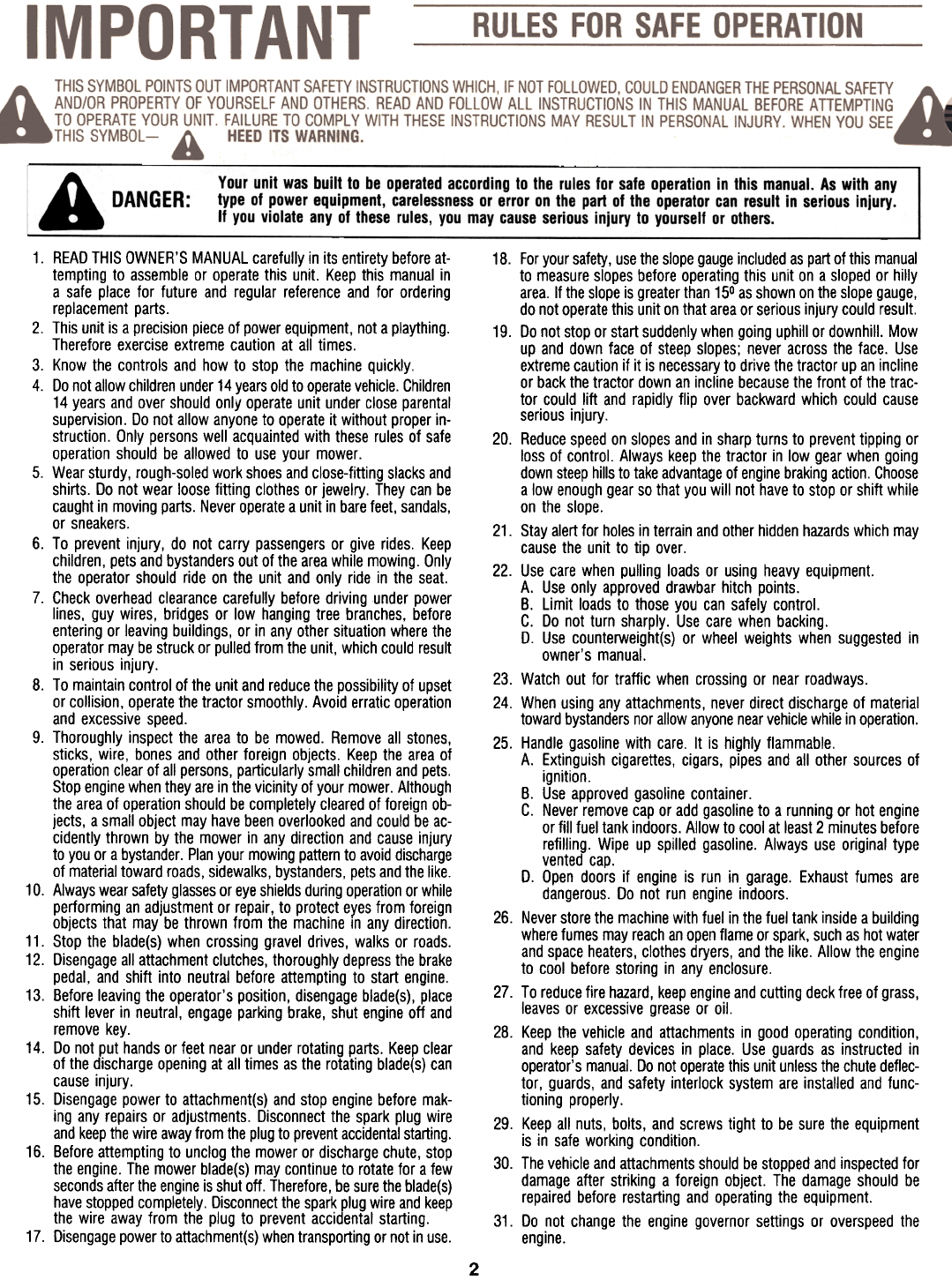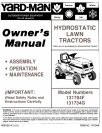
Your unit was built to be operated according to the rules for safe operation in this manual. As with any
type of power equipment, carelessness or error on the part of the operator can result in serious injury.
If you violate any of these rules, you may cause serious injury to yourself or others.
DANGER:
1. READ THIS OWNER'S MANUAL carefully in its entirety before at-
tempting to assemble or operate this unit. Keep this manual in
a safe place for future and regular reference and for ordering
replacement parts.
2. This unit is a precision piece of power equipment, not a plaything.
Therefore exercise extreme caution at all times.
3. Know the controls and how to stop the machine quickly.
4. Do not allow children under 14 years old to operate vehicle. Children
14 years and over should only operate unit under close parental
supervision. Do not allow anyone to operate it without proper in-
struction. Only persons well acquainted with these rules of safe
operation should be allowed to use your mower.
5. Wear sturdy, rough-soled work shoes and close-fitting slacks and
shirts. Do not wear loose fitting clothes or jewelry. They can be
caught in moving parts. Never operate a unit in bare feet, sandals,
or sneakers.
6. To prevent injury, do not carry passengers or give rides. Keep
children, pets and bystanders out of the area while mowing. Only
the operator should ride on the unit and only ride in the seat.
7. Check overhead clearance carefully before driving under power
lines, guy wires, bridges or low hanging tree branches, before
entering or leaving buildings, or in any other situation where the
operator may be struck or pulled from the unit, which could result
in serious injury.
8. To maintain control of the unit and reduce the possibility of upset
or collision, operate the tractor smoothly. Avoid erratic operation
and excessive speed.
9. Thoroughly inspect the area to be mowed. Remove all stones,
sticks, wire, bones and other foreign objects. Keep the area of
operation clear of all persons, particularly small children and pets.
Stop engine when they are in the vicinity of your mower. Although
the area of operation should be completely cleared of foreign ob-
jects, a small object may have been overlooked and could be ac-
cidently thrown by the mower in any direction and cause injury
to you or a bystander. Plan your mowing pattern to avoid discharge
of material toward roads, sidewalks, bystanders, pets and the like.
10. Always wear safety glasses or eye shields during operation or while
performing an adjustment or repair, to protect eyes from foreign
objects that may be thrown from the machine In any direction.
11. Stop the blade(s) when crossing gravel drives, walks or roads.
12. Disengage all attachment clutches, thoroughly depress the brake
pedal, and shift into neutral before attempting to start engine.
13. Before leaving the operator's position, disengage blade(s), place
shift lever in neutral, engage parking brake, shut engine off and
remove key.
14. Do not put hands or feet near or under rotating parts. Keep clear
of the discharge opening at all times as the rotating blade(s) can
cause injury.
15. Disengage power to attachment(s) and stop engine before mak-
ing any repairs or adjustments. Disconnect the spark plug wire
and keep the wire away from the plug to prevent accidental starting.
16. Before attempting to unclog the mower or discharge chute, stop
the engine. The mower blade(s) may continue to rotate for a few
seconds after the engine is shut off. Therefore, be sure the blade(s)
have stopped completely. Disconnect the spark plug wire and keep
the wire away from the plug to prevent accidental starting.
17. Disengage power to attachment(s) when transporting or not in use.
18. For your safety, use the slope gauge included as part of this manual
to measure slopes before operating this unit on a sloped or hilly
area. If the slope is greater than 150 as shown on the slope gauge,
do not operate this unit on that area or serious injury could result.
19. Do not stop or start suddenly when going uphill or downhill. Mow
up and down face of steep slopes; never across the face. Use
extreme caution if it is necessary to drive the tractor up an incline
or back the tractor down an incline because the front of the trac-
tor could lift and rapidly flip over backward which could cause
serious injury.
20. Reduce speed on slopes and in sharp turns to prevent tipping or
loss of control. Always keep the tractor in low gear when going
down steep hills to take advantage of engine braking action. Choose
a low enough gear so that you will not have to stop or shift while
on the slope.
21. Stay alert for holes in terrain and other hidden hazards which may
cause the unit to tip over.
22. Use care when pulling loads or using heavy equipment.
A. Use only approved drawbar hitch points.
B. Limit loads to those you can safely control.
C. Do not turn sharply. Use care when backing.
D. Use counterweight(s) or wheel weights when suggested in
owner's manual.
23. Watch out for traffic when crossing or near roadways.
24. When using any attachments, never direct discharge of material
toward bystanders nor allow anyone near vehicle while in operation.
25. Handle gasoline with care. It is highly flammable.
A. Extinguish cigarettes, cigars, pipes and all other sources of
ignition.
B. Use approved gasoline container.
C. Never remove cap or add gasoline to a running or hot engine
or fill fuel tank indoors. Allow to cool at least 2 minutes before
refilling. Wipe up spilled gasoline. Always use original type
vented cap.
D. Open doors if engine is run in garage. Exhaust fumes are
dangerous. Do not run engine indoors.
26. Never store the machine with fuel in the fuel tank inside a building
where fumes may reach an open flame or spark, such as hot water
and space heaters, clothes dryers, and the like. Allow the engine
to cool before storing in any enclosure.
27. To reduce fire hazard, keep engine and cutting deck free of grass,
leaves or excessive grease or oil.
28. Keep the vehicle and attachments in good operating condition,
and keep safety devices in place. Use guards as instructed in
operator's manual. Do not operate this unit unless the chute deflec-
tor, guards, and safety interlock system are installed and func-
tioning properly.
29. Keep all nuts, bolts, and screws tight to be sure the equipment
is in safe working condition.
30. The vehicle and attachments should be stopped and inspected for
damage after striking a foreign object. The damage should be
repaired before restarting and operating the equipment.
31. Do not change the engine governor settings or overspeed the
engine.
2


















